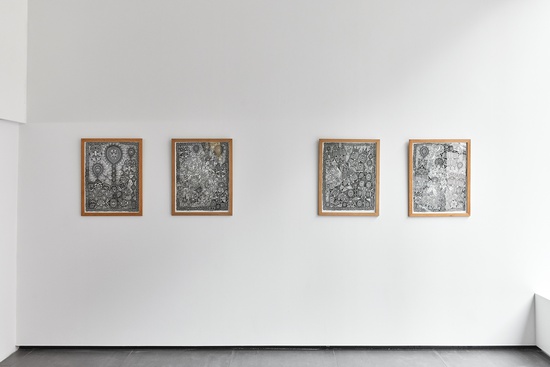19. Four untitled drawings
Marc Lamy
(1997)
In black ink, a dense and intricate web of pattern is formed out of irregular panels, like a patchwork quilt. Organic forms blossom, like a meadow of abstract flowers, haphazardly blooming between mosaics of geometric tiles. These painstakingly detailed drawings are from a series by the French artist Marc Lamy (b. 1939), who began drawing them while incarcerated in a psychiatric hospital in the late 1980s. Suffering from visual and auditory hallucinations for most of his adult life, Lamy began making these works at the age of around 50, when he began drawing with an ‘automatic hand’. Lamy claims he tuned into the supernatural voices which populated his head, entering a state of hypnosis to produce the works.
According to Lamy himself, much of the symbolism and imagery appearing in his semi-abstract works is derived from his early childhood. Lamy’s parents were artists who opened a stained glass studio in Lyon, a city decimated by the Second World War, in a bid to revive medieval glass art. The hollowed out cityscape and sensory overload of the glass studio, along with the ascetic and monastic lifestyle his parents adopted, seem to have had a dramatic and lifelong effect on Lamy’s mental state, which he describes as hypersensitive to image and sound. Within the swirling and shapeshifting forms of his ink drawings are the fragments of experience which left such a deep imprint on the young artist’s formative brain. The structured tile-like motifs that populate Lamy’s drawings are suggestive of the interior of buildings: tiled hallways or rib-vaulted ceilings, perhaps his parents’ glass studio, or the architecture of postwar Lyon, with its Byzantine-influenced basilica.
Striking faces emerge between forms – with birdlike beaks and piercing eyes, they are not quite human or animal, but akin to tribal masks, used in ritual to summon vital energies from the spirit world. These atavistic faces feel primordial, loaded with potential. But they also reflect the way memories are encoded and splintered into scintillating patterns by the human mind, becoming something more intangible, fluid and dreamlike. For Lamy they are a channelling of the traumatising imagery of his early childhood, but they also seem to tap into something larger: some deeper, ancestral knowledge or visioning of the world, induced through excessive mark-making and guided by mysterious voices.
Text by Rosa Abbott


